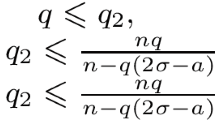Abstract
In this paper we study the global (in time) existence of small data solutions to semi-linear fractional \(\sigma -\)evolution equations with mass and nonlinear memory. Our main goals was to explain on the one hand the influence of the memory term and on the other hand, the influence of higher regularity of the data on qualitative properties of solutions.
Similar content being viewed by others
References
Cui, S.: Local and global existence of solutions to semilinear parabolic initial value problems. Nonlinear Anal. 43, 293–323 (2001)
D’Abbicco, M., Ebert, M.R., Picon, T.: Global existence of small data solutions to the semilinear fractional wave equation. In: Dang, P., Ku, M., Qian, T., Rodino, L.G. (ed.) New Trends in Analysis and Interdisciplinary Applications, Trends in Mathematics, Research Perspectives, Birkhäuser, Basel, pp. 465–472 (2017)
D’Abbicco, M., Lucente, S., Reissig, M.: Semilinear wave equations with effective damping. Chin. Ann. Math. 34B(3), 345–380 (2013)
Kainane Mezadek, A., Reissig, M.: Semi-linear fractional evolution equations with mass or power non-linearity. Nonlinear Differ. Equ. Appl. 25, 42 (2018)
Palmieri, A., Reissig, M.: Semi-linear wave models with power non-linearity and scale-invariant time-dependent mass and dissipation, II. Mathematische Nachrichten, pp. 1–34. (2017)
Runst, T., Sickel, W.: Sobolev spaces of fractional order, Nemytskij operators, and nonlinear partial differential equations, De Gruyter Series in Nonlinear Analysis and Applications, p. 547. Walter de Gruyter & Co., Berlin (1996)
Acknowledgements
The research of this article is supported by the DAAD, Erasmus+ Project between the Hassiba Benbouali University of Chlef (Algeria) and TU Bergakademie Freiberg, 2015-1-DE01-KA107-002026, during the stay of the author at Technical University Bergakademie Freiberg within the period April to July 2017. The author expresses a sincere thankfulness to Prof. Michael Reissig for proposing the interesting topic, for numerous discussions and the staff of the Institute of Applied Analysis for their hospitality. The author thanks the reviewer for his/her comments and suggestions.
Author information
Authors and Affiliations
Corresponding author
Additional information
Publisher's Note
Springer Nature remains neutral with regard to jurisdictional claims in published maps and institutional affiliations.
Appendix
Appendix
1.1 Results from Harmonic Analysis
We recall some results from Harmonic Analysis (cf. with [5]).
Proposition 7.1
Let \(r\in (1,\infty ), p>1\) and \(\sigma \in (0,p)\). Let Q(u) denote one of the functions \(|u|^{p}, \pm u|u|^{p-1}\). Then the following inequality holds:
for any \(u\in H^{\sigma }_{r}(\mathbb {R}^n)\cap L^{\infty }(\mathbb {R}^n)\). Here we use for \(\gamma \ge 0\) and \(1< q< \infty \) the fractional Sobolev spaces or Bessel potential spaces
Moreover, \(\langle D\rangle ^{\gamma }\) stands for the pseudo-differential operator with symbol \(\langle \xi \rangle ^{\gamma } \) and it is defined by \(\langle D\rangle ^{\gamma }u=F^{-1}(\langle \xi \rangle ^{\gamma }F(u))\).
Proof
This result is a special case of the following more general inequality for Triebel-Lizorkin spaces \(F^\sigma _{r,q}\):
where \(q>0\), whose proof may be found in [6, Theorem 1 in Section 5.4.3]. \(\square \)
Proposition 7.2
Let \(r\in (1,\infty ), p>1\) and \(\sigma \in (0,p)\). Let Q(u) denote one of the functions \(|u|^{p}, \pm u|u|^{p-1}\). Then the following inequality holds:
for any \(u\in \dot{H}^{\sigma }_{r}(\mathbb {R}^n)\cap L^{\infty }(\mathbb {R}^n)\), where
Here \(|D|^{\gamma }\) stands for the pseudo-differential operator with symbol \(|\xi |^{\gamma } \) and it is defined by \(|D|^{\gamma }u=F^{-1}(|\xi |^{\gamma }F(u))\).
Proof
We will use a homogeneity argument. For any positive \(\lambda \) we define \(u_\lambda (x)=u(\lambda x)\). Applying Proposition 7.1 to \(u_\lambda \) we get
Since for \(r\in (1,\infty )\) we have the decomposition
and the scaling properties
diving both sides of (7.1) by \(\lambda ^{\sigma -\frac{n}{r}}\) and taking the limit as \(\lambda \rightarrow \infty \) we obtain the desired inequality. \(\square \)
Proposition 7.3
Let \(r\in (1,\infty )\) and \(\sigma >0\). Then the following inequality holds:
for any \(u,v\in H^\sigma _r \cap L^\infty \).
Proof
The result that we want to prove is a special case of the following inequality for Triebel–Lizorkin spaces \(F^\sigma _{r,q}\):
for any \( u,v\in F^\sigma _{r,q} \cap L^\infty \), where \(q>0\), whose proof can be found in [6, Theorem 2 in Section 4.6.4]. \(\square \)
Finally, let us state the corresponding inequality in homogeneous spaces \(\dot{H}^\sigma _r \). For the proof it is possible to follow the same strategy as in the proof of Proposition 7.2.
Proposition 7.4
(Fractional Leibniz formula) Let \(r\in (1,\infty )\) and \(\sigma >0\). Then the following inequality holds:
for any \(u,v\in \dot{H}^{\sigma }_{r}(\mathbb {R}^n)\cap L^{\infty }(\mathbb {R}^n).\)
1.2 Inequalities
First we recall Young’s inequality.
Lemma 7.5
Let \(u \in L^{p}(\mathbb {R}^{n})\) and \(v \in L^{r}(\mathbb {R}^{n})\) with \(1\le p,r\le \infty \). Then \(u*v \in L^{q}(\mathbb {R}^{n})\), where \(1+\frac{1}{q}=\frac{1}{p}+\frac{1}{r}\) and
Finally, we recall the following Lemma from [1]:
Lemma 7.6
Suppose that \(\theta \in [0,1), a\ge 0\) and \(b\ge 0\). Then there exists a constant \(C=C(a,b,\theta )>0\) such that for all \(t>0\) the following estimate holds:
Rights and permissions
About this article
Cite this article
Kainane Mezadek, A. Global Existence of Small Data Solutions to Semi-linear Fractional \(\sigma \)-Evolution Equations with Mass and Nonlinear Memory. Mediterr. J. Math. 17, 159 (2020). https://doi.org/10.1007/s00009-020-01573-9
Received:
Revised:
Accepted:
Published:
DOI: https://doi.org/10.1007/s00009-020-01573-9
Keywords
- Fractional equations
- \(\sigma -\)Evolution equations
- global in time existence
- small data solutions
- nonlinear memory



